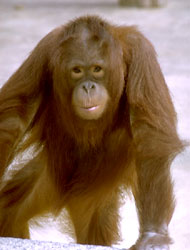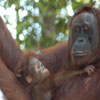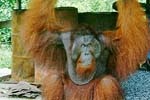

© 2001 California Academy of Sciences courtesy CalPhotos
Classification:
Kingdom: Animalia
Phylum: Chordata
Class: Mammalia
Order: Primates
Family: Hominidae
Genus: Pongo
Species: Pongo pygmaeus, Pongo abelii
Species
There are two Orangutan species, Pongo pygmaeus and Pongo abelii. Pongo pygmaeus lives on the island of Borneo, and Pongo abelii on the island of Sumatra.(3)
This organism develops from three cell layers, the ectoderm, the endoderm, and the mesoderm making it a triploblast. The orangutan has a coelem, or body cavity, as most animals above the flatworm and roundworm do. Orangutans are bilateral, meaning they are of symmetrical arrangement; the organism has a central axis and the body is divided into equivalent right and left halves. And last, the orangutan has a central nervous system and internal organs. The orangutan has many similarities to the human. The word “Orangutan” means “Person of the Forest.”(1)
Physical Description
Orangutans have a large, bulky body. Females are 2.6–3.5 feet tall weighing 110 pounds, and males are 3.2-4.5 feet tall, weighing 200 pounds. They are covered with long, reddish hair. The orangutan has a large head with a prominent mouth area. Males have large cheek flaps, which get larger as they age.(1)



Left: © 2006 Orangutantours. Right: © 2003 Garth Andries.
Preferred Habitat
Orangutans live in Southeast Asia on the islands of Borneo and Sumatra in tropical rainforests, where they reside mostly in trees.(1) They are shy, solitary animals that are active during the day. They live alone in large territories.
Niche
They are omnivores, but plants comprise most of their diet. Fruit is their favorite food, but they also eat insects and small animals such as birds.(1)
Population
The only long-lasting social group, or symbiotic relationship, is that of mother and offspring, which lasts about 7 years. The orangutan is in grave danger of extinction because of their habitat being destroyed by man. Baby orangutans are captured and sold around the world as pets. The orangutans are an endangered species, with only about 30,000 left in the world. (1)
The Evolutionary Tale
It is believed that the orangutan originated about 14 million years ago, in the middle of the Miocene epoch of the Cenozoic Era, in a forest in Asia. The two species that we know today in the genus Pongo live in Asia.(2)
The earliest primates date back to 70 million years ago. The greater apes, which include orangutans as well as gorillas, chimpanzees, and humans split off from the lesser apes (gibbons) about 20 million years ago.(1)
Interestingly, the fossil evidence suggests that there were three major migratory events that occurred during the evolution of the great apes. The first migratory event is thought to have taken place in the late Miocene epoch. It is thought that the ancient ancestors to the modern great apes migrated from Africa into Asia (about 20 million years ago!). Many ancient fossils have since been found in Asia, including Ramapithecus, Ouranopithecus and Dryopithecus. After a great time period, it is estimated that there was a split in the population of great ape ancestors and some migrated from Asia back into Africa, where they since branched and evolved into the modern day chimpanzees, gorillas, and yes, humans. This migratory event was thought to have occurred around 10 million years ago. The lineage that remained in Asia led to the generation of the Orangutan lineages. A third migratory event, then later occurred in Africa (about 100 to 200 thousand years ago, when Homo erectus migrated out of Africa and founded the seeds for the modern day human populations. This is known as the "in and out" of Africa hypothesis. If this scenario did not occur, and our ancestors were truly in Africa the whole time, this would require six different migratory events to have occurred to establish the current populations of apes within Asia, including the following:
| Gibbons | 18 million years ago |
| Oreopithecus | 16 million years ago |
| Lufengpithecus | 15 million years ago |
| Sivapethecus and Orangutans | 14 million years ago |
| Dryopithecus | 13 million years ago |
| Ouranopithecus | 12 million years ago |
This seems to be less likely, although it may also be possilbe. Further fossil finds will likely reveal additional evidence to support one of these hypotheses.
The Jaw of the Orangutan
Anatomical evidence also supports a link between the Asian apes and our own ancestory. For example, the orangutan shares a unique feature with the human jaw, which is thick dental enamel. Additional anatomical finds, show that ancient fossils, like Ouranopithecus, that were found in Asia share more similarities with Australopithecus fossils found in Africa (the lineage that is proposed to be our ancestral lineage) than that of more ancient fossils found in Africa.
Challenge Question
One or two species of orangutan? Many scientists think that the two groups of orangutans are subspecies, and others disagree. The two groups of orangutans have been geographically separated for a long time and are now physically distinct from one another, although similar enough genetically to interbreed.(1)




 Go to quick links
Go to quick search
Go to navigation for this section of the ToL site
Go to detailed links for the ToL site
Go to quick links
Go to quick search
Go to navigation for this section of the ToL site
Go to detailed links for the ToL site